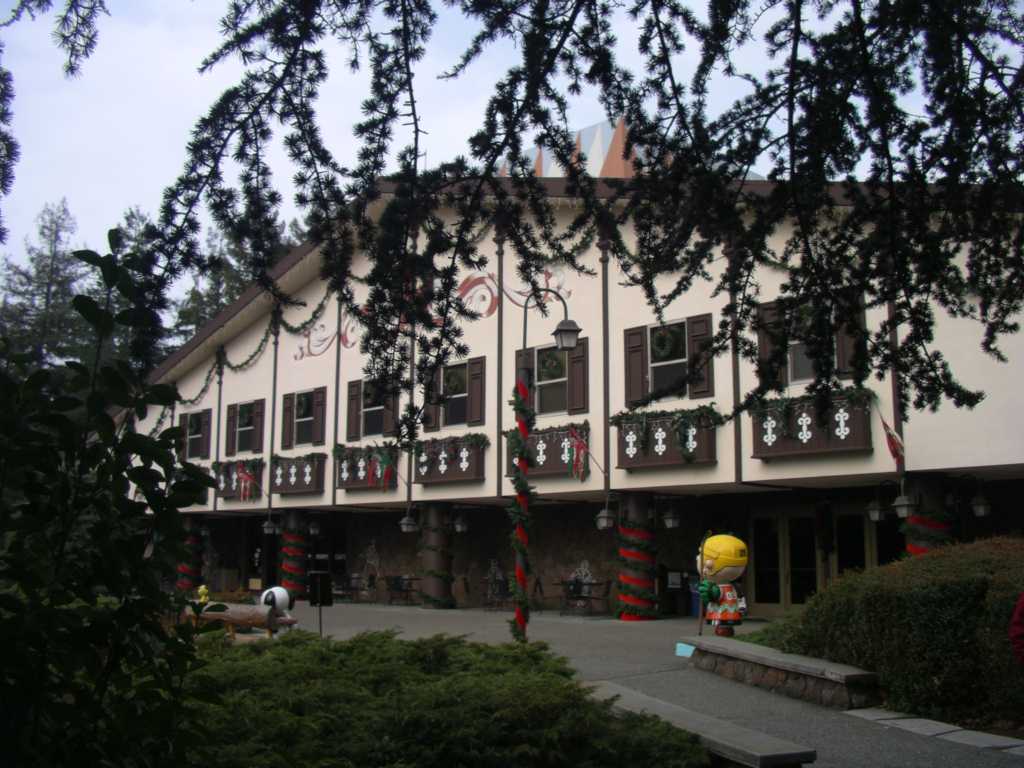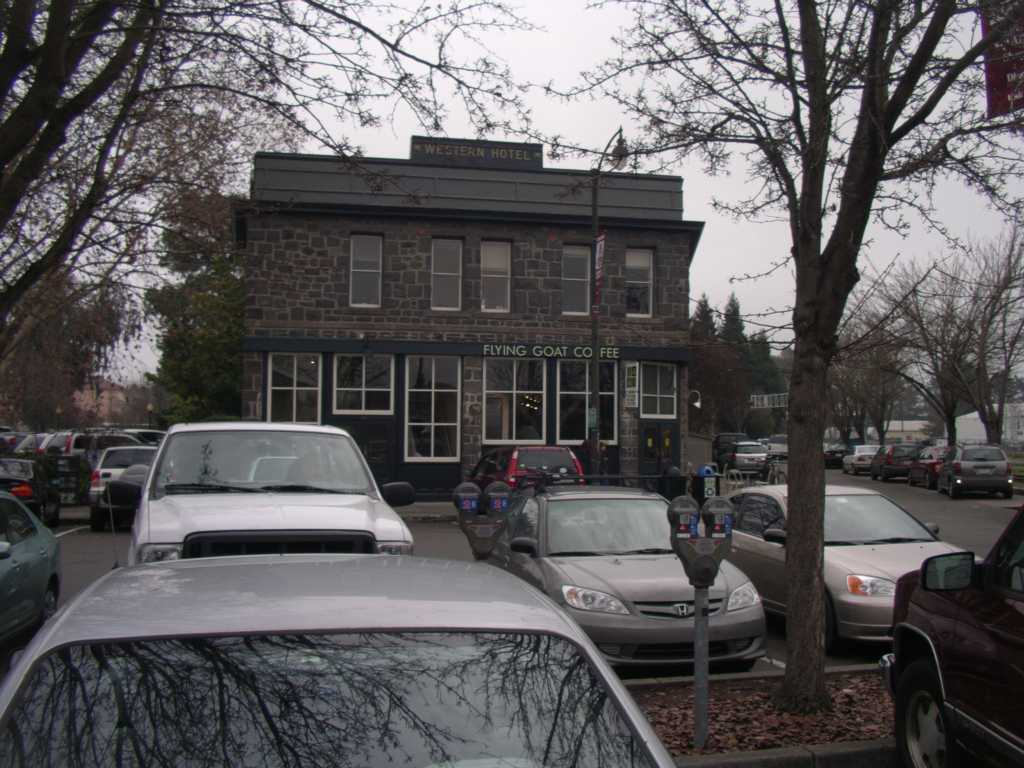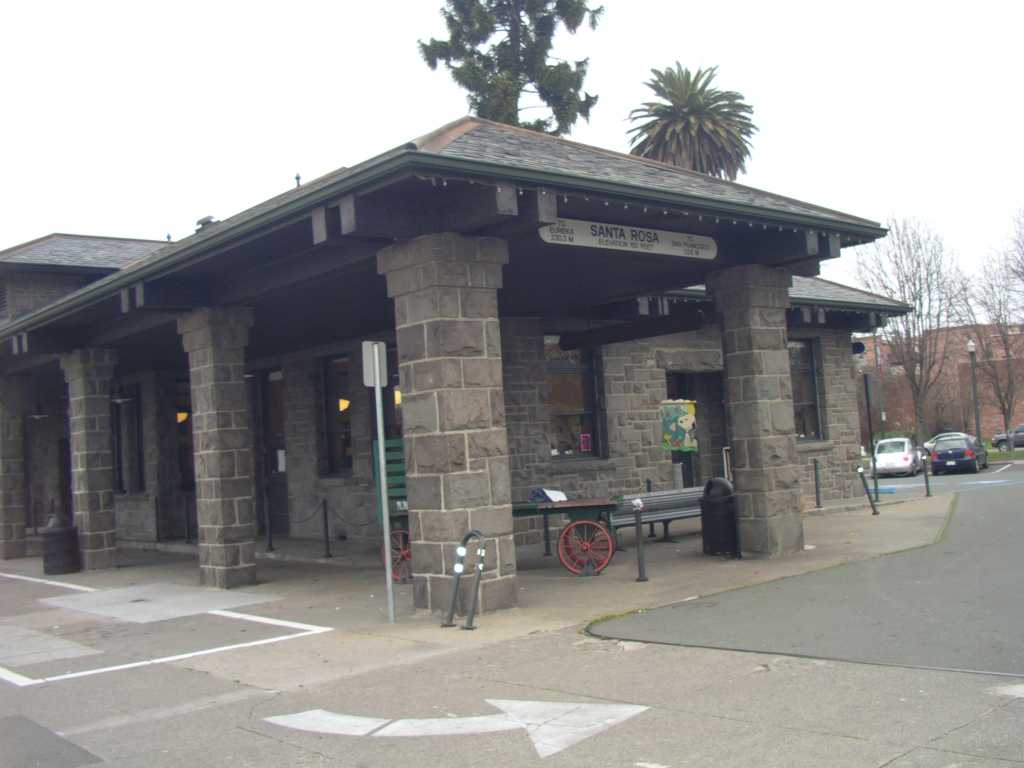Posts: 854
Threads: 52
Joined: Nov 2009
Hi all, having never been there, it's hard to get a good feel for the area I want to model ( I do browse in Google earth street view etc but it's tedious on my internet link) . I've had some correspondence with several people 'in the know', and they tell me that among other things, what characterizes a typical 'average' Northern Californian town is the relative absence of brick buildings (the stuff there is loads off in HO, DPM etc), and more concrete re-enforced buildings (earthquake 'proof') with stucco walls, and also still a lot of timber buildings. In regards to these, can anyone give me some suggestions, on which laser cut wooden structures I could use to create a believable modern scene (talking early 1990's here). I find that a lot of this type of models are for steam era railroads, so a few pointers would help. Of course there is your typical modern freight buildings made of metal frames, walls and roofs (similar to some of the items from from Pike Stuff I'd guess).
Cheers,
Koos
Be sure to visit my model railroad blog at <!-- m --><a class="postlink" href="http://www.namrr.blogspot.com">http://www.namrr.blogspot.com</a><!-- m -->
Posts: 1,897
Threads: 40
Joined: Dec 2008
Pikestuff sheet metal is common for many commercial buildings. Most likely use would be machinery repair shops, and maybe some stores out in the country. Larger buildings like warehouses would likely be reinforced concrete tilt up, like some of the buildings that Kurt or Reinhard have built. Much of Northern California was first settled during the gold rush in 1849 and following. Wood was frequently used for home construction. In the hills with a lot of trees log cabins would not be uncommon. In town the houses would be more conventional frame construction with the various methods of construction being evident. I think the most common I've seen is board and batten, or lapped. Commercial buildings in town were different. The old west towns were originally built with wood, but stores, saloons, the dentist or doctor's office were built close together, often sharing walls between buildings. If a fire started, the entire business district of the town was destroyed. Most of the towns were rebuilt with brick after the second or third fire, but many of the old buildings remain wood. In the downtown areas of most of the old towns in Northern California, wooden buildings will not look a lot different from the main street you see in most Hollywood westerns. Downtown in most larger cities and many of the towns will look like Old Sacramento with brick buildings. Unfortunately, the brick was fine unless there was an earthquake, in which case the brick walls caved in. That is why new construction is seldom done with brick or else it is brick facing on a conventional wood frame, and the brick is just decorative. Many of the older cities with old brick structures have had the brick structures reinforced with a vertical concrete column every few feet on the sides and back of the building to preserve the old architecture while making the buildings safe in an earthquake.
Here are a couple of web sites to give you some ideas:
<!-- m --><a class="postlink" href="http://www.columbiacalifornia.com/">http://www.columbiacalifornia.com/</a><!-- m -->
<!-- m --><a class="postlink" href="http://www.oldsacramento.com/">http://www.oldsacramento.com/</a><!-- m -->
<!-- m --><a class="postlink" href="http://www.oldtownauburnca.com/">http://www.oldtownauburnca.com/</a><!-- m -->
I hope this is helpful to you. If you have further questions, throw them up here and I'll try to help you out.
Posts: 1,215
Threads: 89
Joined: Dec 2008
I have to ask this first, how far north? Do you have an city or county set on?
Reason why I ask is that I lived in northern california, around the sacramento area, but further north is much different
Tom
Model Conrail
PM me to get a hold of me.
Posts: 1,897
Threads: 40
Joined: Dec 2008
I forgot to mention that if you have a specific town or a town that is near to where you want to model, you can do a search on the town name,ca in Google or other search engine and it will frequently give you various web sites for the town. If the town is a historical town, you may see pictures of the more historical buildings in town.
Posts: 854
Threads: 52
Joined: Nov 2009
Yes I should have been more specific, as California does change quite a bit depending where you are. Okay: I'm modeling the California Northern Railroad. The layout on one side starts in Napa Jct, and progresses to Davis Ca. I've got some rolling hills with grass and trees (and passing a vineyard or two) between the two points. I was initially going to model a bit of the West valley sub area, but I can't cram that in the area without taking too many concessions, so I'm leaving that out. Just Napa Jct to Davis, perhaps a tiny bit of the line between Davis and Sacramento but that's it.
So I'm not too far north, and not too far south, but going west/east (ish) so to speak. Will that help in setting the 'scene'?
Koos
Be sure to visit my model railroad blog at <!-- m --><a class="postlink" href="http://www.namrr.blogspot.com">http://www.namrr.blogspot.com</a><!-- m -->
Posts: 410
Threads: 17
Joined: Dec 2008
A lot of the buildings in the Napa downtown areas (Yountville, Napa, Santa Rosa, Sonoma) are actually DPM style brick buildings, but they have been reinforced for Earthquake preparedness via several methods. It looks a lot like typical small town USA. Yeah, a lot of California is earthquake country, but not all of it. I live in Stockton, in the San Joaquin Valley and the only reason a lot of the old brick buildings are going away is modern reconstruction and revitalization in our downtown, but not just because brick isn;t earthquake safe. There are ways that engineers have found to make brick more earthquake safe. Stockton has an earthquake fault running through it, but it has been stable since the 1840's. Ironically, it's down on the south end of town near all of the rail yards. The area you're modeling has the occasional shaker and is siesmically active, but you'll find a large variety of construction techniques around there. A lot of it though is old fashioned because afterall, it is the wine country.
Tom Carter
Railroad Training Services
Railroad Trainers & Consultants
Stockton, CA
<!-- m --><a class="postlink" href="http://www.railroadtrainingservices.com">http://www.railroadtrainingservices.com</a><!-- m -->
<!-- e --><a href="mailto:tomwcarter@railroadtrainingservices.com">tomwcarter@railroadtrainingservices.com</a><!-- e -->
![[Image: gaugetraingifsigUP.gif]](http://i79.photobucket.com/albums/j137/wprm/gaugetraingifsigUP.gif)
Posts: 1,897
Threads: 40
Joined: Dec 2008
You can simulate earthquake proofing on a brick building by putting in a "reinforced concrete column" about 2 feet wide from foundation to roof using something like Sculptamold over the top of the brick. Do it about every scale 10 feet or so on the sides and back. Generally the front of the building is left alone to preserve the architectural historical look. I think some of the brick buildings in Old Sacramento may have pieces of steel strap bolted to the bricks on the inside near the roof and perhaps between the windows or windows and doors. The only evidence on the out side of the building would be black bolt heads and washers on the outside of the building.
Posts: 854
Threads: 52
Joined: Nov 2009
Cheers everyone for your replies, that helps. I had almost dismissed most of DPM's offerings as I wanted the setting to look correctly, and not too 'east coast', if you know what I mean. As far as visible re-enforcements are concerned, are there any pictures that you can point me to, that show this on the outside of a building? the concrete beams or the bolts and washers mentioned are some I'm interested in. Cheers!
Koos
Be sure to visit my model railroad blog at <!-- m --><a class="postlink" href="http://www.namrr.blogspot.com">http://www.namrr.blogspot.com</a><!-- m -->
Posts: 1,897
Threads: 40
Joined: Dec 2008
I tried to do a search on Google, but didn't find anything on the first 3 or 4 pages that pertained to brick. Most of the topics on reinforced masonry had to do with either cinder blocks with rebar or poured concrete reinforced with rebar. I plan to go to Sacramento this summer to the NMRA convention. While I'm there, I'll try to get some pictures of the reinforcement methods for you.
Posts: 120
Threads: 13
Joined: Dec 2008
I was in Davis just a few months ago. Here's the coordinates you can type into Google for the Davis Wye. 38.543913, -121.737938
Other than the strikingly beautiful depot at Davis, there's a wide variety of structure types in "Old Town" Davis. From brick as mentioned (although not as common as in other parts of the country. The main building material is Stucco. It's applied over most homes, businesses and industries around there.
An extremely modelgenic building in the area (right on the west leg of the wye) is Davis' Ace hardware, that has an old SP 50" DD boxcar as part of the store!
There's an abundance of newer concrete structures around the town in the commercial area, with plenty of "postwar" modern buildings filling the gaps between the wooden victorian era structures and older stucco structures.
Most importantly, use bing maps to see the buildings in a "flyby" type aerial view (*versus satellite) <!-- m --><a class="postlink" href="http://www.bing.com/maps/#JmNwPTM4LjU0Mzc1NTkyNTkzMjM3fi0xMjEuNzM3ODAzNzAzNTMwNzQmbHZsPTE4JmRpcj0wJnN0eT1y">http://www.bing.com/maps/#JmNwPTM4LjU0M ... 0wJnN0eT1y</a><!-- m -->
I hope this helps. 
Posts: 1,215
Threads: 89
Joined: Dec 2008
Russ Bellinis Wrote:While I'm there, I'll try to get some pictures of the reinforcement methods for you. Here's some of Old Sac I've taken a few years back, the second photo you can clearly see the concrete block reinforcements
![[Image: DSC00301.jpg]](http://i21.photobucket.com/albums/b267/tomustang/zzz/DSC00301.jpg)
![[Image: DSC00300.jpg]](http://i21.photobucket.com/albums/b267/tomustang/zzz/DSC00300.jpg)
Tom
Model Conrail
PM me to get a hold of me.
Posts: 410
Threads: 17
Joined: Dec 2008
The reason you won't find many photos online of the steel rod reinforcements is that is was by design so unobtrusive you really don't notice it unless you really look hard. All you'll see (and thus easy to recreate on a model structure) is about a 12" square piece of flat plate steel (styrene) with a Nut-bolt-washer casting on it on the outside. Put them on in pairs across from each other, and be sure to turn the square plate 45 degrees so it looks like a diamond and you're all set.
At least that's how I see them do it around this part of Northern California and in Old Sacramento as well.
Tom Carter
Railroad Training Services
Railroad Trainers & Consultants
Stockton, CA
<!-- m --><a class="postlink" href="http://www.railroadtrainingservices.com">http://www.railroadtrainingservices.com</a><!-- m -->
<!-- e --><a href="mailto:tomwcarter@railroadtrainingservices.com">tomwcarter@railroadtrainingservices.com</a><!-- e -->
![[Image: gaugetraingifsigUP.gif]](http://i79.photobucket.com/albums/j137/wprm/gaugetraingifsigUP.gif)
Posts: 2,540
Threads: 63
Joined: Dec 2008
Since you mentioned Santa Rosa, here are a few shots from our trip last year.




Just some random buildings selected by my wife. The first 2 are the old station and a building across from it. The last 2 are a more modern structure called Snoopy's Home Ice.
David
Moderato ma non troppo
Perth & Exeter Railway Company
Esquesing & Chinguacousy Radial Railway
In model railroading, there are between six and two hundred ways of performing a given task.
Most modellers can get two of them to work.
Posts: 854
Threads: 52
Joined: Nov 2009
Mileswestern Wrote:I was in Davis just a few months ago. Here's the coordinates you can type into Google for the Davis Wye. 38.543913, -121.737938
Other than the strikingly beautiful depot at Davis, there's a wide variety of structure types in "Old Town" Davis. From brick as mentioned (although not as common as in other parts of the country. The main building material is Stucco. It's applied over most homes, businesses and industries around there.
An extremely modelgenic building in the area (right on the west leg of the wye) is Davis' Ace hardware, that has an old SP 50" DD boxcar as part of the store!
There's an abundance of newer concrete structures around the town in the commercial area, with plenty of "postwar" modern buildings filling the gaps between the wooden victorian era structures and older stucco structures.
Most importantly, use bing maps to see the buildings in a "flyby" type aerial view (*versus satellite) <!-- m --><a class="postlink" href="http://www.bing.com/maps/#JmNwPTM4LjU0Mzc1NTkyNTkzMjM3fi0xMjEuNzM3ODAzNzAzNTMwNzQmbHZsPTE4JmRpcj0wJnN0eT1y">http://www.bing.com/maps/#JmNwPTM4LjU0M ... 0wJnN0eT1y</a><!-- m -->
I hope this helps. 
I got to find that hardware store, that sounds like a fun project to build! The Davis station I am well familiar with, I found it before, I have the construction drawings of the depot, and it will be part of my future building plans. My layout will feature a compressed version of the Davis Wye with the depot building etc.
Cheers!
Koos
Be sure to visit my model railroad blog at <!-- m --><a class="postlink" href="http://www.namrr.blogspot.com">http://www.namrr.blogspot.com</a><!-- m -->
Posts: 854
Threads: 52
Joined: Nov 2009
Russ Bellinis Wrote:I tried to do a search on Google, but didn't find anything on the first 3 or 4 pages that pertained to brick. Most of the topics on reinforced masonry had to do with either cinder blocks with rebar or poured concrete reinforced with rebar. I plan to go to Sacramento this summer to the NMRA convention. While I'm there, I'll try to get some pictures of the reinforcement methods for you.
Russ , thanks very much for your help!
Koos
Be sure to visit my model railroad blog at <!-- m --><a class="postlink" href="http://www.namrr.blogspot.com">http://www.namrr.blogspot.com</a><!-- m -->
|



![[Image: gaugetraingifsigUP.gif]](http://i79.photobucket.com/albums/j137/wprm/gaugetraingifsigUP.gif)

![[Image: DSC00301.jpg]](http://i21.photobucket.com/albums/b267/tomustang/zzz/DSC00301.jpg)
![[Image: DSC00300.jpg]](http://i21.photobucket.com/albums/b267/tomustang/zzz/DSC00300.jpg)